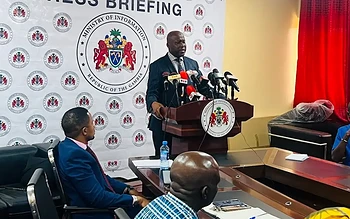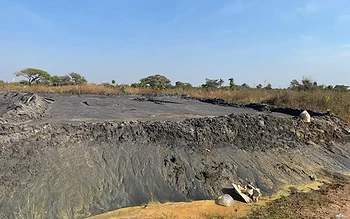- The Sheriff of the High Court of The Gambia sold 725 heads of cattle belonging to ex-president Yahya Jammeh below valuation by at least D2.4m.
- The inventory of Jammeh’s livestock filed before the late Justice Buba Jawo recorded 52 sheep, 15 ducks and 15 goats. There is no evidence these livestock made it to the market as the Sheriff’s report has no record of them.
- Internal documents at the Ministry of Justice claim a former manager of Jammeh’s Farato and Siffoe farms, ex-major Gibril Jammeh, has reportedly stolen 400 cattle “immediately” after Jammeh fled into exile. Sources say ex-major Jammeh has since fled to Casamance.
- There are no official records of the buyers of Jammeh’s herd of cows .
- Though the Sheriff claimed it could not sell all of the cattle, its report failed to provide details of the whereabouts of the number remaining to be sold.

Yahya Jammeh, ex-Gambian leader, was reluctantly persuaded by the firepower of the regional economic bloc— ECOWAS— to leave power after a failed attempt to annul the results of December 2016 presidential election. A new leader, Adama Barrow, sworn-in at The Gambia’s Embassy in Dakar, Senegal, on January 19, 2017, approved the deployment of regional soldiers into the country.
Jammeh faces allegations of many extrajudicial killings and human rights violations. The Gambian military, accused of loyalty to him, was pushed to the fringe as regional forces took control of key security installations, including the presidency. In Kanilai— Jammeh’s home village— this change was more apparent.
A former military Major, Alieu Sowe, who attempted to run for president in 2021, was the farm manager who was also taking care of Jammeh’s house in Kanilai. “The emotions were very high,” said ex-Major Sowe.
“They (NAWEC) cut light, water. They cut everything in Kanilai. With all these animals and materials. It was even risky for my life.” Aside from his household belongings, the ex-president Jammeh kept a variety of livestock and wild animals in Kanilai, including cattle, camels, ostriches, sheep and goats. The soldiers and residents of Jammeh’s house had to rely on generators for electricity, according to Sowe.
“It took until May (2017), when government officials started coming. After four months,” said Sowe.
Livestock ‘at risk of being stolen’
Gambia’s former strongman, Yahya Jammeh, was barely 6 months into self-imposed exile in Equatorial Guinea, and the state investigations into his financial dealings and those of his close associates were underway in Banjul.
The Ministry of Justice under Abubacarr Tambadou had already sought a High Court order in May 2017, granted by Justice Amina Saho Ceesay , freezing his assets.The Court would also appoint Augustus Prom as the receiver. The Ministry of Justice would make two early applications before the court for the sale of livestock and release of lands within the Tourism Development Area (TDA). Justice Saho refused their application to release lands with the TDA in July 2018.
“For the government to descend upon the Respondent’s properties at this point in time, in the absence of the conclusion of the criminal investigation and a subsequent order of confiscation, will, with respect amount to nothing short of a travesty,” said Justice Saho in her ruling.
About six months before Justice Saho’s ruling, the late Justice Buba Jawo has released the the former ruler’s livestock for sale. During a vacation of the High Court in January 2018, the Ministry of Justice filed a motion ex-parte before the late Justice Buba Jawo seeking for the release of the livestock. The sale of the livestock, according to the Commission, could not wait for the end of the inquiry which came in March 2019. In an affidavit sworn by the former Registrar of Companies, Alieu Jallow, the State made an urgent case for the sale of Jammeh’s livestock.
“During the tagging exercise, it was discovered that the number of cattle has reduced to less than 600 since my report,” said Jallow.
“I verily believe that livestock run the risk of being stolen and wasted unless urgent action is taken to dispose of the same.”
Justice Jawo, who opened a temporary file for the case, yielded. He issued an order releasing the livestock for sale.
.

The sale below valuation
The first visit of the Janneh Commission to Jammeh’s ranches in 2018 was jointly conducted with members of the Gambia Livestock Marketing Agency (GLMA) who were tasked to do the valuation. But GLMA did not participate in the sale, according to the Agency’s former Director General Ebrima Cham. “We do not even know how the animals were sold,” said Cham.
Records seen by The Republic show that at least 642 heads of cattle were initially identified during a visit to Jammeh’s three ranches by officials of the Janneh Commission in January 2018. This was worth at least D10. 7m, according to a valuation conducted by GLMA.
The Sheriff sold at least 104 more heads of cattle than the 642 valued by GLMA, yet turned in about D2.4m less than the revenue projected by the Agency.
In their affidavit filed before the late Justice Jawo, the State took inventory of 746 heads of cattle in Jammeh’s ranches: 634 in Kanilai, 79 in Farato and 33 in Banjulinding. But only 725 were eventually sold by the Sheriff of the High Court of The Gambia, generating D8. 3m.
The only record on the sale of Jammeh’s livestock, according to current Sheriff Omar Jabang, is the 3-page report of his predecessor— now a High Court judge, Justice Sheriff B Tabally— which did not have the name of the buyers. However, several sources have told The Republic State Minister Hamat Bah has bought a significant number.
“I deliberately refused to buy anything from Yahya Jammeh’s properties because I don’t want anything from Jammeh,” said Minister Bah. “No one in this world will provide you with any evidence of my purchase of any of Yahya Jammeh’s properties . I am making it abundantly clear that I did not buy anything from Yahya Jammeh’s assets.”

Dispute over numbers
In January 2017, when Jammeh fled to Equatorial Guinea, there were two ex-military Majors in charge of his farms, Gibril Jammeh who was in charge of his farms in Siffoe and Farato, and Alieu Sowe who was in charge of the farm in Kanilai.
The court that froze Jammeh’s assets placed the livestock under the custody of the GLMA, though the Agency had never taken custody of the animals, according to its former Director General Ebrima Cham. They remained in the ranches in the three settlements.
A series of visits were made to Jammeh’s ranches to record the livestock. The first visit led by the Secretary of the Janneh Commission, Alagie Mamadi Kurang, had recorded 642 heads of cattle in January 2018: 558 in Kanilai, 59 in Farato and 25 in Banjulinding.
In the motion ex-parte filed by the State before the late Justice Jawo, they claimed to have found 634 heads of cattle in Kanilai, 79 in Farato, and 33 in Banjulinding. Ex-Major Sowe, Jammeh’s Farm Manager in Kanilai, told The Republic that he handed over at least 800 heads of cattle.
“The number I handed over was between 800 to 900 heads of cattle. When I left, whether some died or not, I cannot testify to that…,” said ex-Major Sowe.
Sowe claimed his inventory of Jammeh’s assets is in the custody of his brother who has left the country for Guinea Bissau. While the Sheriff’s report confirmed its sale did not cover all of the cattle, it failed to explain how much remains to be sold and where they are.
“The team was reliably informed that some cattle went for grazing and were not accounted for as they are not gathered to facilitate sale of same. To date, the sale of all cattle could not be completed and hence the delay in the submission of this report. This report, therefore, only covers sale of the livestock that were available for sale,” said the report.
Ex-Major Sowe said it was unlikely for over 200 cattle to die between the time he handed over to the time of the sale. “Even if there was theft, no one can steal over 50 cattle without anyone knowing about it. And in that area, everyone is told these are Yahya Jammeh’s properties. They were very protective of it,” added ex-Major Sowe.
![]()
The missing cattle
The Republic could not ascertain the exact number of cattle Jammeh left in his ranches as he went into exile in Equatorial Guinea.
There are at least four different official records about the number of cattle. The 642 initially recorded by the Janneh Commission, the 725 reportedly sold by the Sheriff and the 746 recorded in a motion filed before Justice Jawo in 2018. In their report, the Sheriff claimed there were some outstanding numbers of cattle that were not sold, but failed to provide any detail on their whereabouts.
Several sources close to Jammeh’s family and his APRC party have claimed the numbers to be above 1000 heads of cattle in Kanilai alone.
On July 5, 2017, the Ministry of Justice wrote a letter to the Defense Headquarters of the Gambia Armed Forces claiming the former Major, Gibril Jammeh, stole 400 head of cattle after the departure of the former leader into exile.
“I have been directed to inform your good office and request you to conduct an investigation into these alleged activities for possible action,” said a letter to the Defense Headquarters.
Gibril has since fled to the Casamance region in southern Senegal, according to Kebba Toumanding Sanneh, the lawmaker for Foni Jarrol.
The spokesperson of the military did not respond to our inquiry about the military’s findings into allegations against ex–major Gibril Jammeh. The Ministry of Justice did not also respond to questions until the time of the publication.
No trace of other livestock, wild animals
The inventory filed before Justice Jawo recorded 52 sheep, 15 ducks and 15 goats. There is no evidence these livestock made it to the market as the Sheriff’s report has no record of them.
As Jammeh went to Equatorial Guinea, he left behind a variety of livestock and wild animals. The Court records suggest that the livestock and wild animals were stolen, and smuggled into Senegal.
“There is no animal in Kanilai right now. Everything is taken,” said Almameh Gibba, the National Assembly member for Foni Kansala.
On July 23, 2018, the Ministry of Justice— through the Court presided over by Justice Amina Saho Ceesay— sought help from Interpol and judicial officers of Senegal to trace Jammeh’s “missing” livestock and wild animals.
“If you will also be pleased to further instruct the Police Force, Interpol Office and other competent authorities to assist the Gambian investigators look into the allegations pertaining to moveable properties such as vehicles, cattle, camels and wildlife that are believed to have been smuggled to Casamance from Kanilai,” stated a part of the letter of request written by Justice Saho to the Justices of the Superior Courts of the Republic of Senegal. It is unclear if the Gambian authorities have since engaged their Senegalese counterpart regarding Jammeh’s “missing” livestock and wild animals.
When reached for comment, the former Sheriff and now a High Court Justice who sold the cattle, Sheriff B. Tabally, said he could not grant an interview because of restrictions on speaking to the media. Alieu Jallow claimed he was not part of the sale and could not thus provide any information.
Be our accomplice! We rely on donor funding and donation from individuals to support our investigations. Click donate to support our work!


